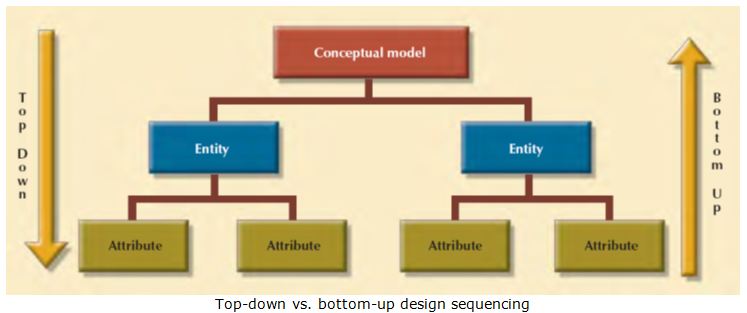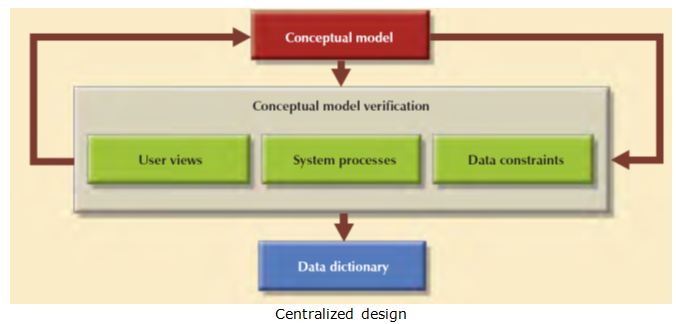Database Design Strategies
There are two classical approaches to database design:
• Top-down design starts by identifying the data sets and then defines the data elements for each of those sets. This process involves the identification of different entity types and the definition of each entity’s attributes.
• Bottom-up design first identifies the data elements (items) and then groups them together in data sets. In other words, it first defines attributes, and then groups them to form entities.
The two approaches are illustrated in the following Figure:

The selection of a primary emphasis on top-down or bottom-up procedures often depends on the scope of the problem or on personal preferences. Although the two methodologies are complementary rather than mutually exclusive, a primary emphasis on a bottom-up approach may be more productive for small databases with few entities, attributes, relations, and transactions. For situations in which the number, variety, and complexity of entities, relations, and transactions is overwhelming, a primarily top-down approach may be more easily managed.
Centralized VS. Decentralized Design:
The two general approaches (bottom-up and top-down) to database design can be influenced by factors such as the scope and size of the system, the company’s management style, and the company’s structure (centralized or decentralized). Depending on such factors, the database design may be based on two very different design philosophies: centralized and decentralized.
Centralized design is productive when the data component is composed of a relatively small number of objects and procedures. The design can be carried out and represented in a fairly simple database. Centralized design is typical of relatively simple and/or small databases and can be successfully done by a single person (database administrator) or by a small, informal design team. The company operations and the scope of the problem are sufficiently limited to allow even a single designer to define the problem(s), create the conceptual design, verify the conceptual design with the user views, define system processes and data constraints to ensure the efficacy of the design, and ensure that the design will comply with all the requirements. The following figure summarizes the centralized design option. Note that a single conceptual design is completed and then validated in the centralized design approach.
Centralized design:
Decentralized design might be used when the data component of the system has a considerable number of entities and complex relations on which very complex operations are performed. Decentralized design is also likely to be employed when the problem itself is spread across several operational sites and each element is a subset of the entire data set. Consider the following diagram.

Decentralized design:
In large and complex projects, the database design typically cannot be done by only one person. Instead, a carefully selected team of database designers is employed to tackle a complex database project. Within the decentralized design framework, the database design task is divided into several modules. Once the design criteria have been established, the lead designer assigns design subsets or modules to design groups within the team. Each design group creates a conceptual data model corresponding to the subset being modeled. Each conceptual model is then verified individually against the user views, processes, and constraints for each of the modules. After the verification process has been completed, all modules are integrated into one conceptual model. Naturally, after the subsets have been aggregated into a larger conceptual model, the lead designer must verify that the combined conceptual model is still able to support all of the required transactions.
Keep in mind that the aggregation process requires the designer to create a single model in which various aggregation problems must be addressed.
• Synonyms and homonyms. Various departments might know the same object by different names (synonyms), or they might use the same name to address different objects (homonyms). The object can be an entity, an attribute, or a relationship.
• Entity and entity subtypes. An entity subtype might be viewed as a separate entity by one or more departments. The designer must integrate such subtypes into a higher-level entity.
• Conflicting object definitions. Attributes can be recorded as different types (character, numeric), or different domains can be defined for the same attribute. Constraint definitions, too, can vary. The designer must remove such conflicts from the model.
You May Also Like:
Database Development Life Cycle
Conceptual Design in Database Design Process

